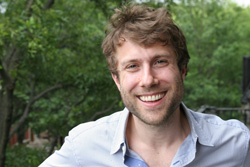"You're not a failure if you decide to leave Brooklyn," Ms. Ghiorse said. "People move to New York with a plan, a dream, and sometimes it doesn't work out that you can live that lifestyle. It takes a lot of money."
As a server at Marlow & Sons, the nose-to-tail temple in Williamsburg, Ms. Ghiorse said she loved being surrounded by "that unbelievably saturated population" of creative influencers, like James Murphy from LCD Soundsystem.
While she savors the space and mental calm of the suburbs, she finds herself looking hopefully for signs of creative ferment. "We've found it in pockets," Ms. Ghiorse said. "Once in a while, you'll think, 'This place gets it,' because they have a Fernet Branca cocktail on their menu."
The signs are there, if you know where to look.
On a visit to Hastings on a recent gray Tuesday, a stroll down the snow-flecked sidewalks of Warburton Avenue, a main drag, revealed more than a few glimpses of "Portlandia" popping up in an otherwise "Mayberry R.F.D." tableau.
The gluten-free bakery, By the Way, sits across the street from Juniper, the farm-to-table restaurant that wouldn't look out of place on Smith Street, the restaurant row that cuts through Carroll Gardens, Brooklyn. Nearby is Maisonette, a home-décor shop that sells felted-wool gazelle heads, for those who prefer their antlers cruelty-free. The owners are Maria Churchill and Kevin McCarthy, recent refugees from the East Village.
The fact that there is a main street to stroll is a big draw for former Brooklynites who find sprawling, car-culture suburbs alienating. These pedestrian-friendly towns, filled with low-rise 19th century brick buildings and non-chain shops, offer a version of village-style living that Jane Jacobs, the Greenwich Village urbanist, would have approved of.
"Walking to pick up milk, to nip over to the farmers' market, is priceless," said Helen Steed, a creative director in fashion in her early 40s whose family moved from Brooklyn to Irvington four years ago. "It's more familiar, less suburban."
Indeed, the sturdy, retro, all-American character of the river towns fits well with the whole Filson/Woolrich heritage-brand aesthetic. People who set their cultural compass to the Brooklyn Flea appreciate the authenticity.
"Hastings-on-Hudson is a village, in a Wittgensteinian sort of way," Mr. Wallach said. He added, "We are constantly hearing about the slow-food movement, the slow-learning movement and the slow-everything-else. So why not just go avant-garde into a slow-village movement?"
Indeed, in the era of artisanal chic, a move up the Hudson feels like Back to the Land Lite. Brooklyn locavores settle in comfortably at The Village Dog in Tarrytown, which serves a salmon boudin hot dog, with sustainable fish sourced from Pierless Fish in Brooklyn; or at Harper's, a bar and restaurant in Dobbs Ferry, where Clark Moore, the bartender, barrel-ages cocktails on the premises.
No wonder Marco Arment, the former lead developer for Tumblr who recently moved to Hastings from Park Slope, said he no longer needs to run off to the country every three-day weekend.
The slower pace and cheaper space also make it easier to pursue the D.I.Y. hobbies and maker-culture businesses that Brooklyn has become famous for.
This is not to say the river towns are Brooklyn North. The mood is still sleepy and commuter-oriented, and real estate, while cheaper than Cobble Hill, is expensive by national standards (don't even get the locals started on property taxes). Furthermore, the relative lack of racial diversity is striking to newcomers.
Marie Labropolous recently moved from a one-bedroom rental in Brooklyn to a four-bedroom 1970s split-level in Hartsdale, about 10 minutes from her shop in Dobbs Ferry. She and her husband, Simeon Papacostas, now have space for a music studio in their basement, where they enjoy regular "pajama jams," she said.
"We keep to ourselves a lot more, keep to our hobbies a lot more, which for creative types is great," said Ms. Kalliste, 33. "Having a little bit of isolation, you become even more creative."
There are some things, however, that she refuses to let go. "I still have my Brooklyn phone number," Ms. Labropolous said. "I'm not giving it up."


